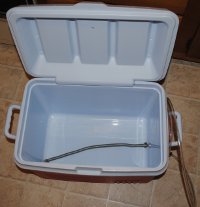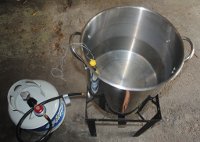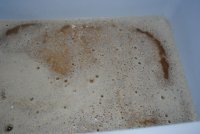All grain brewing is a way of taking your brewing to a new level. It allows you to have more control over your recipe and creates a whole new world of opportunities as far as selection goes. There is a huge selection of grains that just don't have equivalents in the extract scene.
The first step to all grain brewing is recipe. The simplest all grain recipe you can create is known as a Single Malt and Single Hop (SMaSH) brew. Even though it doesn't sound as exciting as your typical clone brew recipe you may see, a SMaSH truely highlights the flavors of a given ingredient. By creating a SMaSH you can taste what flavors your grain and hops will add to your beer. This process will help you with recipe creation in the long run. But... a SMaSH doesn't have to be boring either. People have been known to create some truly interesting and tastey brews by only using a single type of grain and a single style of hop.
Now for the process of brewing your first all grain beer. The process doesn't differ all that much from the process explained in the extract tutorial. So if you haven't read that yet, it's recommended you check it out first over here. The only major difference is that you don't have the sugars from the grain (a.k.a extract) to start with so you must extract them yourself through the Mash and Sparging. This tutorial will focus on the Mashing process.
What You'll Need

Mash/Lauter Tun (≈ $42). Which can be built using this tutorial.
Grain; any kinds your heart desires (≈ $1-$2 per pound)
Sanitizer (≈ $3) - This will last a long time
Large Stainless Steel Spoon or Wooden Paddle (≈ $5 for SS Spoon)
Pitcher (≈ $5) - The bigger the better and preferrably graduated
Kitchen Thermometer (≈ $3)
Kitchen Scale (≈ $20 for a digital scale)
Large Pot for Heating Water (≈ $30) or a Turkey Fryer with Stand (≈ $60)
How 'bout Some Mashing
1) Sanitize
The first step of any brewing procedure should always be to sanitize anything that will come in contact with any of your ingredients. Granted everything that you will be using for your beer that comes out of the mashing process will be boiled, but it never hurts to give you equipment one last clean before you use it.
 2) Heat Some Water
2) Heat Some Water
Ok. This step requires some calculations. Depending on the method of sparging you are using, the amount of water you need to heat now will vary. For your standard fly sparging, the amount of water you will need typically will equal about half of your boil volume plus the combined weight of your grain multiplied by your grist ratio (typically around 1.2 quarts/pound). If you are batch sparging, you will use the amount you calculate for your mash volume.
Regardless of how much water you use, you are shooting for a target grain temperature in your mash tun. The temperature you pick will affect the amount of sugar you extract from the grain as well as the mouthfeel your beer will have when all is said and done. A typical mash temperature is 155°F. But remember, you want your grain to have this temperature after adding the water. The grain will absorb some of the heat after the water is added so we will add ten degrees to the temperature we heat the water too. So drop your thermometer into your pot of heating water and let it go until it hits 165°F. While that water is warming up, you can take care of the next step.
3) Measure Your Grain
If you were lucky enough to create a recipe that let you order grain in the exact amounts you needed, you can skip this step. However, most times you will have to order a little extra because some grains are sold by the pound when you only need fractions of a pound. This step is simple enough though. Just use your trusty kitchen scale to measure out the amount of grain for which your recipe calls.
4) Let's Make a Grain Bed
Well now that all the grain is measured, dump it into your mash tun. Hopefully by now your water has warmed up to the 165°F mentioned in Step 2. You'll want to carefully pour the water into the mash tun. Carefully because a pot full of 165 degree water is very hot and heavy; all making it very easy to burn yourself.

Now you need to stir all of your grain to make sure there isn't any large clumps sitting around in the mash tun. Next, measure the temperature. If the mash isn't very close to the target temperature of 155°F you will need to add hot or cold water, depending on the direction you need to go. Only add a little at a time though, it is very easy to overshoot your target. However much water you add to hit your target mash temp you can subtract in your sparge and you will hopefully still hit your target gravity and volumes. Once your at the target temperature, you just let the mash sit. Stir every fifteen minutes or so for an hour.
5) Sparging
 2) Heat Some Water
2) Heat Some Water Now you need to stir all of your grain to make sure there isn't any large clumps sitting around in the mash tun. Next, measure the temperature. If the mash isn't very close to the target temperature of 155°F you will need to add hot or cold water, depending on the direction you need to go. Only add a little at a time though, it is very easy to overshoot your target. However much water you add to hit your target mash temp you can subtract in your sparge and you will hopefully still hit your target gravity and volumes. Once your at the target temperature, you just let the mash sit. Stir every fifteen minutes or so for an hour.
Now you need to stir all of your grain to make sure there isn't any large clumps sitting around in the mash tun. Next, measure the temperature. If the mash isn't very close to the target temperature of 155°F you will need to add hot or cold water, depending on the direction you need to go. Only add a little at a time though, it is very easy to overshoot your target. However much water you add to hit your target mash temp you can subtract in your sparge and you will hopefully still hit your target gravity and volumes. Once your at the target temperature, you just let the mash sit. Stir every fifteen minutes or so for an hour.